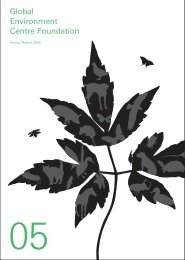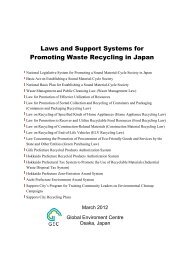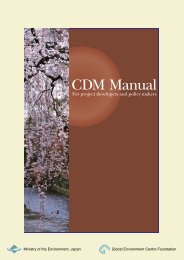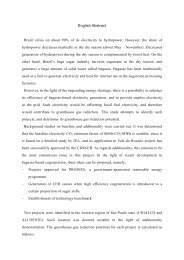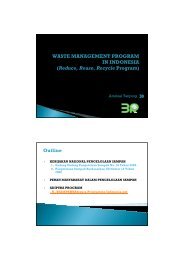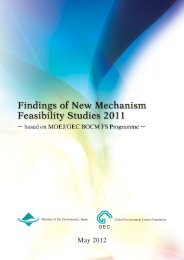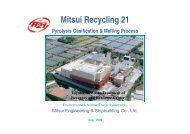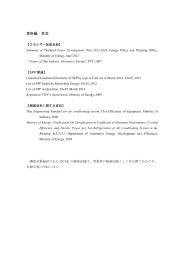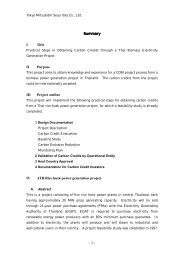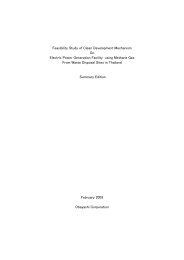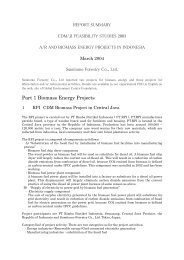PDF File - GEC
PDF File - GEC
PDF File - GEC
You also want an ePaper? Increase the reach of your titles
YUMPU automatically turns print PDFs into web optimized ePapers that Google loves.
Title and Version<br />
Number<br />
6. Tool to determine<br />
project emissions<br />
from flaring<br />
gases containing<br />
methane –<br />
Version 1 [EB28,<br />
Annex 13]<br />
7. Tool to calculate<br />
the emission<br />
factor for an<br />
electricity system<br />
– Version 1.1<br />
[EB35, Annex 12]<br />
1. Tool for the<br />
demonstration<br />
and assessment<br />
of additionality<br />
in A/R CDM<br />
project activities<br />
– Version 2 [EB35,<br />
Annex 17]<br />
Scope and<br />
applicability<br />
Parameter(s) to<br />
be determined<br />
Scope and<br />
applicability<br />
Parameter(s) to<br />
be determined<br />
Scope<br />
Scope, Applicability and Parameters<br />
This tool provides procedures to calculate project emissions from flaring of a<br />
residual gas stream (RG) containing methane. This tool is applicable under the<br />
following conditions:<br />
• The RG to be flared contains no other combustible gases than methane,<br />
carbon monoxide and hydrogen;<br />
• The RG to be flared shall be obtained from decomposition of organic material<br />
(through landfills, bio-digesters or anaerobic lagoons, among others) or from<br />
gases vented in coal mines (coal mine methane and coal bed methane).<br />
• Project emissions from flaring of the residual gas stream in year y (tCO 2 e)<br />
[PE flare,y ]<br />
• Flare efficiency in hour h based on measurements or default values [ηflare,h]<br />
This methodological tool determines the CO 2 emission factor for the displacement<br />
of electricity generated by power plants in an electricity system, by calculating the<br />
“operating margin” (OM) and “build margin” (BM) as well as the “combined margin”<br />
(CM). The OM refers to a cohort of power plants that reflect the existing power<br />
plants whose electricity generation would be affected by the proposed CDM<br />
project activity. The BM refers to a cohort of power units that reflect the type of<br />
power units whose construction would be affected by the proposed CDM project<br />
activity.<br />
This tool may be referred to in order to estimate the OM, BM and/or CM for<br />
the purpose of calculating baseline emissions for a project activity substitutes<br />
electricity from the grid, i.e. where a project activity supplies electricity to a grid<br />
or a project activity that results in savings of electricity that would have been<br />
provided by the grid (e.g. demand-side energy efficiency projects).<br />
Note that this tool is also referred to in the “Tool to calculate project emissions<br />
from electricity consumption” for the purpose of calculating project and leakage<br />
emissions in case where a project activity consumes electricity from the grid or<br />
results in increase of consumption of electricity from the grid outside the project<br />
boundary.<br />
• Combined margin CO 2 emission factor for grid connected power generation in<br />
year y (tCO 2 /MWh) [EF grid,CM,y ]<br />
• Build margin CO 2 emission factor for grid connected power generation in year<br />
y (tCO 2 /MWh) [EF grid,BM,y ]<br />
• Operating margin CO 2 emission factor for grid connected power generation in<br />
year y (tCO 2 /MWh) [EF grid,OM,y ]<br />
II. AFFORESTATION AND REFORESTATION (A/R) RELATED TOOLS<br />
Applicability<br />
Parameter(s) to<br />
be determined<br />
• This tool provides for a step-wise approach to demonstrate additionality in A/R<br />
CDM projects.<br />
• Project participants proposing new baseline methodologies may incorporate<br />
this tool in their proposal. Project participants may also propose other<br />
approaches for the demonstration of additionality to the EB for its<br />
consideration.<br />
• In validating the application of this tool to a proposed project activity, DOEs<br />
should assess credibility of all data, rationales, assumptions, justifications and<br />
documentation provided by project participants to support the selection of<br />
the baseline and demonstration of additionality.<br />
Procedure: Project participants shall apply the following five steps:<br />
• STEP 0. Preliminary screening based on the starting date of the A/R project<br />
activity;<br />
• STEP 1. Identification of alternative land use scenarios to the A/R project<br />
activity;<br />
• STEP 2. Investment analysis to determine that the proposed project activity is<br />
not the most economically or financially attractive of the identified land use<br />
scenarios; or<br />
• STEP 3. Barriers analysis; and<br />
• STEP 4. Common practice analysis.<br />
• Forestation of the land within the proposed project boundary performed with<br />
or without being registered as the A/R CDM project activity shall not lead to<br />
violation of any applicable law even if the law is not enforced;<br />
• The use of this tool to determine additionality requires the baseline<br />
methodology to provide for a stepwise approach justifying the determination<br />
of the most plausible baseline scenario. Project participants proposing new<br />
baseline methodologies shall ensure consistency between the determination<br />
of a baseline scenario and the determination of additionality of a project<br />
activity; and<br />
• This tool is not applicable to small scale afforestation and reforestation project<br />
activities.<br />
This procedure does not use its own parameters.<br />
96



